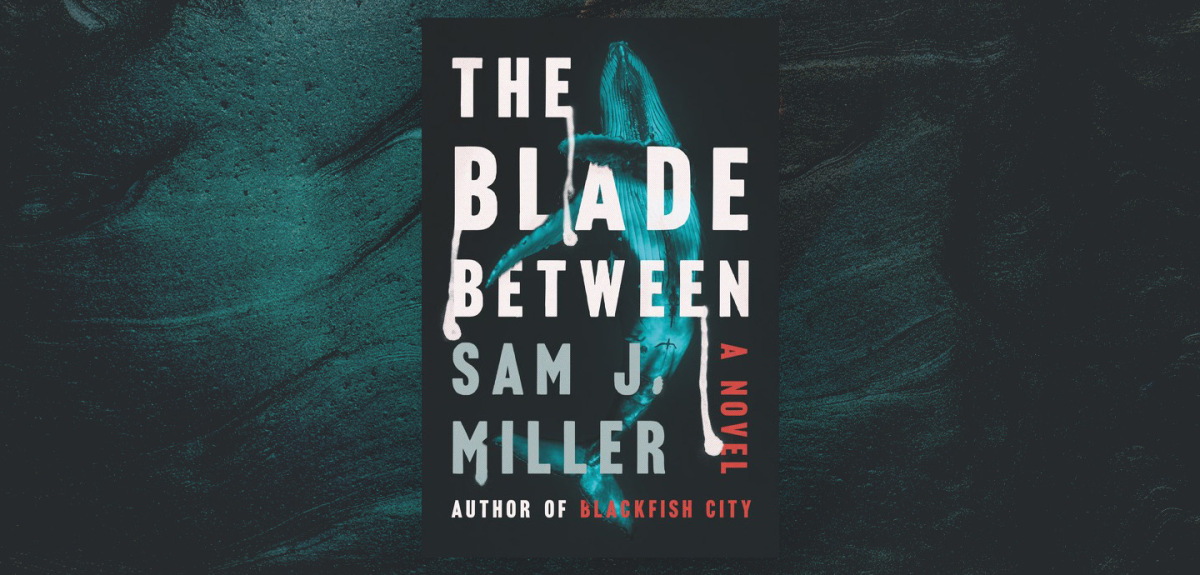[ad_1]
Sam J. Miller’s new book The Blade Between is not a laid-back read for a languid afternoon. No, this is a sit-up-straight book. Full of jarring juxtapositions, this book is as engrossing as it is challenging. While it requires your attention, The Blade Between rewards you with a heady, addictive mix of realism and wild creativity.
Newly sober Ronan Szepessy wakes up on a train northbound from New York City without any idea of how he got there or where he is going. Reluctantly, he disembarks in Hudson, the hometown he fled shortly after high school.
Though mystified by his unplanned, involuntary trip, Ronan nevertheless leans into the visit, wading into the debris of his past and the tragedies of his present. He grapples with the grief of seeing his father consumed by dementia. He rekindles both his friendship and his feelings for his high school best friend and first love Dom, now married to Attalah, another high school classmate. And he recoils at the way that Hudson has changed since he has been away.
The neighborhood has been gentrified. All of the familiar features of the Hudson of Ronan’s childhood—the Italian restaurant, the toy store, the bakery, even his own father’s former butcher shop—have been wiped away by shiny new art galleries and antique shops. With new people to match.
Despite his barely-repressed longing for her husband, Ronan teams up with Attalah to fight the onslaught of outsiders taking over Hudson. Together they hatch a scheme that goes far beyond anything Attalah has tried in her community organizing work before. Their methods are certainly unethical and borderline illegal, but they just may work to restore Hudson to the community Ronan remembers from his childhood.
On the one hand, The Blade Between is firmly grounded in realism. Ronan’s reluctant return to his hometown and his negotiation of the emotional landmines that accompany going home again will mirror the experience of many, as will the wrenching sorrow he feels watching his father suffer from dementia. Similarly, but on a larger scale, Miller’s depiction of gentrification is wrought in clinical but visceral detail. Gentrification’s interlinked consequences —evictions, displacement, loss of community, homelessness, poverty, and drug use—are drawn in clear, bright lines, effortlessly illustrating the facets of a complex social problem playing out in communities all across America.
Yet, through this bedrock of realism erupt geysers of the bizarre and supernatural. Though Hudson may be experiencing challenges shared by many other cities, it is unique in its status as a portal for the otherworldly. The hints are there from the beginning. Ronan’s twisted dreams breach his waking life. He dines in a restaurant that was closed years earlier. Though Hudson is hundreds of miles from the coast, sea water bubbles up in strange locations all over the city.
Katch, an acquaintance of Ronan’s who died a couple of months earlier, explains that “Hudson exists outside of time and space as you understand them. Shit gets confusing.” According to Katch, Hudson is enveloped by the dreamsea, a “spiritual membrane that made the normal rules of life and death inapplicable.” The godlike beings who inhabit the dreamsea use human ghosts like Katch to communicate that they, like Ronan and Attalah, also want to defend Hudson against outsiders. And they have summoned Ronan to help with their cause and imbued him with special powers to do it.
Ronan’s anti-gentrification efforts are indeed buoyed by powers far greater than his own, causing Ronan and Attalah’s careful machinations to spiral out of control, putting the safety of the city and all of its inhabitants at great risk.
As trouble stirs and tension mounts, the events in The Blade Between become truly outlandish. But rather than veering toward the ridiculous, the character of Ronan makes it all work. His open, probing intellect invites the reader to share all his turmoil and trauma and contradictions. So when he reacts to the revelation of ghosts and gods and time slips with near hysteria, it lessens the burden of suspending disbelief. And though Ronan too lacks knowledge of the “rules” of this paranormal world, he moves forward anyway, bringing the reader along with him.
The intimacy that Miller creates between Ronan and the reader does not come at the expense of the other characters. Though they are kept in third person, Dom and Attalah are nevertheless worlds unto themselves, their perspectives intertwined with Ronan’s but unique and distinct.
In the same way, Miller’s careful construction of the book’s many other characters and their roiling, clashing needs and motivations makes it easy to believe that an entire city could be involved in a dark conspiracy, embroiled in a secret civil war that culminates in bloody unrest.
With all this going on, you may suspect that this story maneuvers like a barge, but instead it advances with speed and precision. The staccato rhythm of the chapters and the quick cuts between characters makes the narrative vibrate with energy. Even as the plot thickens—like, really thickens—and the characters accrue, the story’s pace somehow increases, hurtling us towards a breathless and breathtaking conclusion.
Though it occasionally flirts with chaos, The Blade Between maintains an exhilarating balance between verisimilitude and unshackled imagination. On the latter, Miller goes all in, and it’s a pleasure to follow.

FICTION
The Blade Between
By Sam J. Miller
Ecco Press
Published December 1, 2020

[ad_2]
Source link
